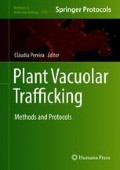Abstract
The CRISPR/Cas9 system from Streptococcus pyogenes is an increasingly popular tool for genome editing due to its ease of application. Here we demonstrate genomic DNA fragment removal using RNA directed Cas9 nuclease in barley. The high mutation frequency confirms the exceptional efficiency of the system and its suitability for generating loss-of-function mutant lines that may be used in functional genetics approaches to study endomembrane trafficking pathways and posttranslational protein modifications. The generation of doubled haploids from genome edited plants allows the recovery of true breeding lines that are instantly homozygous for the edited alleles.
Access this chapter
Tax calculation will be finalised at checkout
Purchases are for personal use only
References
Buchholz F (2009) Engineering DNA processing enzymes for the postgenomic era. Curr Opin Biotechnol 20(4):383–389
Hilscher J, Burstmayr H, Stoger E (2017) Targeted modification of plant genomes for precision crop breeding. Biotechnol J 12(1). https://doi.org/10.1002/biot.201600173
Bortesi L, Zhu C, Zischewski J, Perez L, Bassié L, Nadi R, Forni G, Lade SB, Soto E, Jin X, Medina V, Villorbina G, Muñoz P, Farré G, Fischer R, Twyman RM, Capell T, Christou P, Schillberg S (2016) Patterns of CRISPR/Cas9 activity in plants, animals and microbes. Plant Biotechnol J 14:2203–2216. https://doi.org/10.1111/pbi.12634
Pacher M, Puchta H (2016) From classical mutagenesis to nuclease-based breeding–directing natural DNA repair for a natural end-product. Plant J. https://doi.org/10.1111/tpj.13469
Vuylsteker C, Cuvellier G, Berger S, Faugeron C, Karamanos Y (2000) Evidence of two enzymes performing the de-N-glycosylation of proteins in barley: expression during germination, localization within the grain and set-up during grain formation. J Exp Bot 51:839–845
Rademacher T, Sack M, Arcalis E, Stadlmann J, Balzer S, Altmann F, Kunert R, Fischer R, Stoger E (2008) Recombinant antibody 2G12 produced in maize endosperm efficiently neutralizes HIV-1 and contains predominantly single-GlcNAc N-glycans. Plant Biotechnol J 6:189–201. https://doi.org/10.1111/j.1467-7652.2007.00306.x
Hensel G, Floss DM, Arcalis E, Sack M, Melnik S, Altmann F, Rutten T, Kumlehn J, Stoger E, Conrad U (2015) Transgenic production of an anti HIV antibody in the barley endosperm. PLoS One 10:e0140476. https://doi.org/10.1371/journal.pone.0140476
Kapusi E, Corcuera-Gómez M, Melnik S, Stoger E (2017) Heritable genomic fragment deletions and small indels in the putative ENGase gene induced by CRISPR/Cas9 in barley. Front Plant Sci 8:540. https://doi.org/10.3389/fpls.2017.00540
Kapusi E, Hensel G, Coronado MJ, Broeders S, Marthe C, Otto I, Kumlehn J (2013) The elimination of a selectable marker gene in the doubled haploid progeny of co-transformed barley plants. Plant Mol Biol 81:149–160. https://doi.org/10.1007/s11103-012-9988-9
Tingay S, McElroy D, Kalla R, Feig S, Wang M, Thornton S, Brettell R (1997) Agrobacterium tumefaciens-mediatedbarley transformation. Plant J 11:1369–1376
Hensel G, Kumlehn J (2004) Genetic transformation of barley (Hordeum vulgare L.) by co-culture of immature embryos with Agrobacteria. In: Curtis IS (ed) Transgenic corps of the world – essential protocols. Kluwer, Dordrecht, pp 35–44
Garfinkel DJ, Nester EW (1980) Agrobacterium tumefaciens mutants affected in crown gall tumorigenesis and octopine catabolism. J Bacteriol 144:732–743
Wang T, Wei JJ, Sabatini DM, Lander ES (2014) Genetic screens in human cells using the CRISPR-Cas9 system. Science 343:80–84
Jiang W, Zhou H, Bi H, Fromm M, Yang B, Weeks DP (2013) Demonstration of CRISPR/Cas9/sgRNA-mediated targeted gene modification in Arabidopsis, tobacco, sorghum and rice. Nucleic Acids Res 41(20):e188. https://doi.org/10.1093/nar/gkt780
Lazo GR, Stein PA, Ludwig RA (1991) A DNA transformation-competent arabidopsis genomic library in agrobacterium. Biotechnology (N Y) 9(10):963–967
Pallotta MA, Graham RD, Langridge P, Sparrow DHB, Barker SJ (2000) RFLP mapping of manganese efficiency in barley. Theor Appl Genet 101:1100–1108
Acknowledgment
We thank Stanislav Melnik for sequence analysis and Maria Corcuera-Gómez for technical assistance. This work was supported by the Austrian Research Fund FWF (I1461-B16).
Author information
Authors and Affiliations
Corresponding author
Editor information
Editors and Affiliations
Rights and permissions
Copyright information
© 2018 Springer Science+Business Media, LLC, part of Springer Nature
About this protocol
Cite this protocol
Kapusi, E., Stöger, E. (2018). Detection of CRISPR/Cas9-Induced Genomic Fragment Deletions in Barley and Generation of Homozygous Edited Lines via Embryogenic Pollen Culture. In: Pereira, C. (eds) Plant Vacuolar Trafficking. Methods in Molecular Biology, vol 1789. Humana Press, New York, NY. https://doi.org/10.1007/978-1-4939-7856-4_2
Download citation
DOI: https://doi.org/10.1007/978-1-4939-7856-4_2
Published:
Publisher Name: Humana Press, New York, NY
Print ISBN: 978-1-4939-7855-7
Online ISBN: 978-1-4939-7856-4
eBook Packages: Springer Protocols

